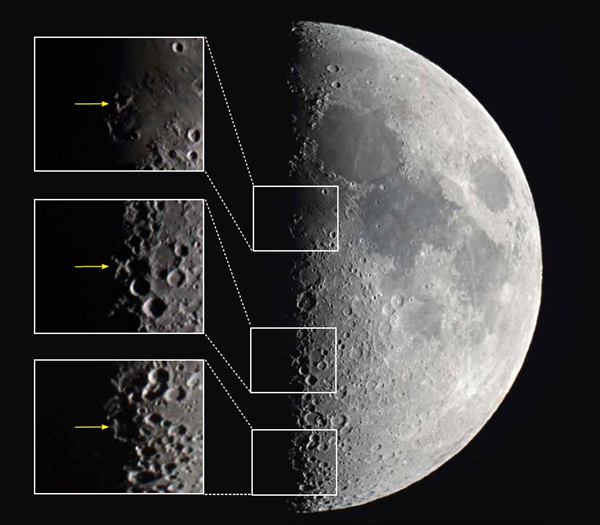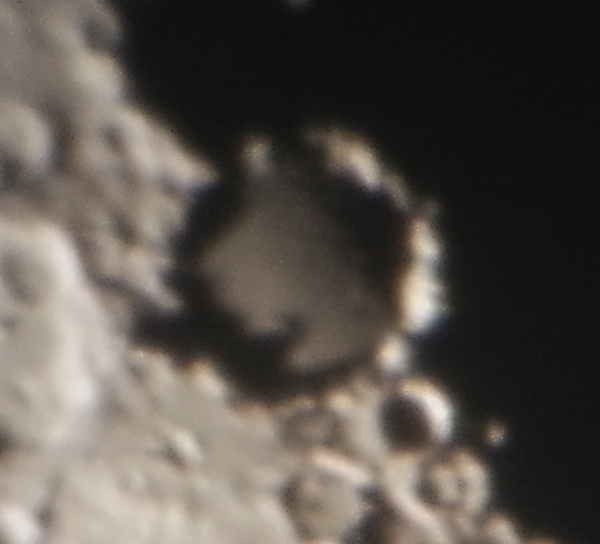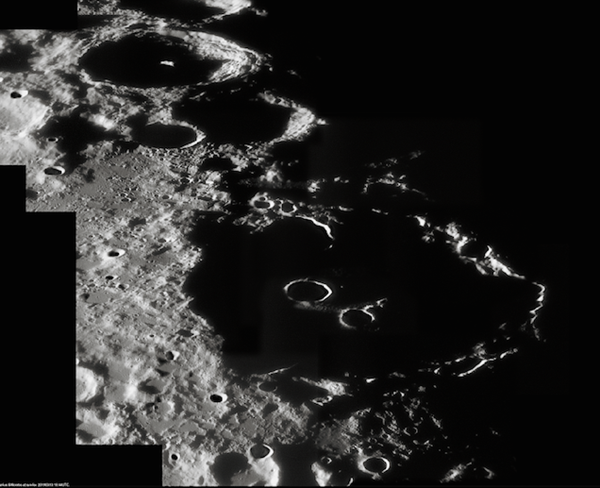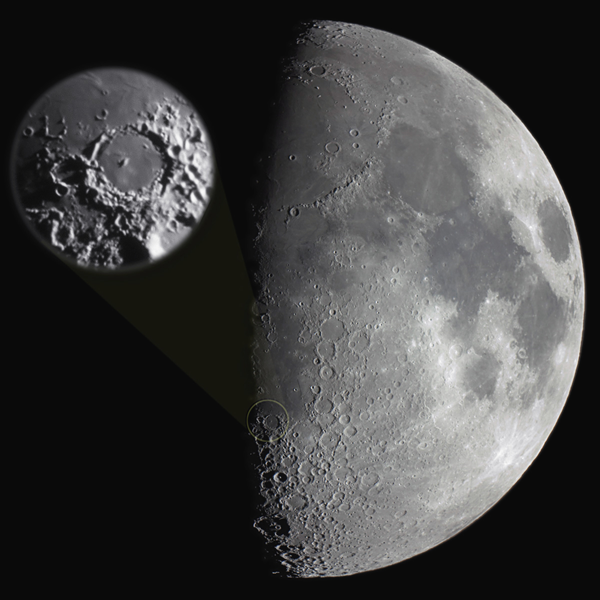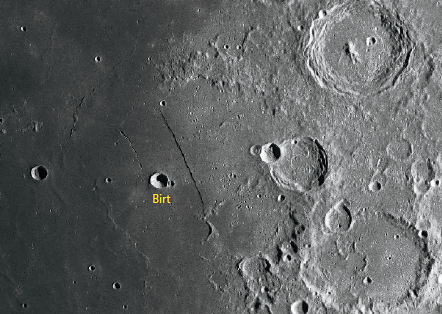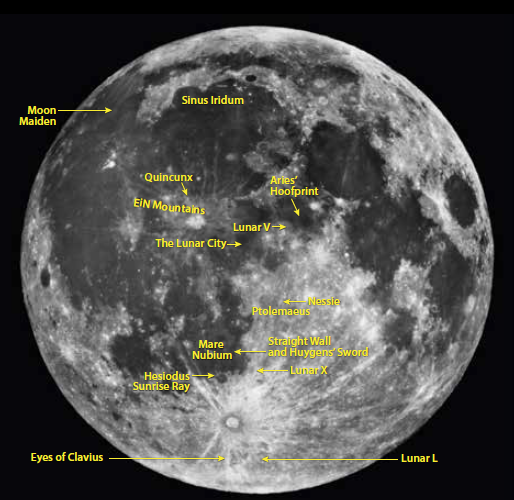Some observers refer to such strange lighting phenomena as clair-obscur effects. The term is adopted from an oil painting technique developed during the Renaissance that uses varying shades of colors and contrasts to create dramatic, three-dimensional effects. The Italian term chiaroscuro (translated as “light-dark”) is also used often to describe the same technique.
I have collected a baker’s dozen lunar clair-obscur effects to whet your appetite. To help zero in on when to look, each description includes the prime time of visibility in terms of days after New Moon (often called the Moon’s age). Be aware, however, that some are more challenging than others. A few remain visible for several nights in a row, while others disappear after a few hours because the Sun’s changing angle wipes them from view.
Another factor that makes viewing some of these features trickier than others is that they require knowing more than just lunar age. You also need to know the colongitude of the Sun. Colongitude is the exact selenographic (lunar) longitude of the “morning” terminator, the line of sunrise on the Moon. Like longitude on Earth, colongitude is measured in degrees.
Fortunately, you can use a freeware program to find the Sun’s colongitude at any given time: www.internetsv.info/MoonCalc.html. The only data you’ll need to enter is the date and the Universal Time.
Lunar X
(Lunar Day 6.9) Let’s begin our hunt with the one clair-obscur effect that has probably garnered more attention in online discussion forums than any other. First noticed in August 2004 by Canadian amateur astronomer David Chapman, the Lunar X — also known to some as the Werner X or the Purbach Cross — is easy to see if you look in the right place at the right time. The shape is formed by the confluence of four lunar craters: Purbach, La Caille, Regiomontanus, and Blanchinus. Purbach forms the eastern side of the X, while Blanchinus creates the western side. La Caille forms its northern boundary, and Regiomontanus marks the southern section. One of the X’s namesakes, the 43-mile-wide (70 kilometers) Werner crater, does not contribute to the feature directly. Instead, as Chapman suggests, “Werner is the closest well-lit crater and makes an obvious beacon for observers.”
If the timing is right, it’s fascinating to watch the Sun rise over the X, slowly unveiling its ragged form over the course of an hour or so. The first rays catch the southeastern wall of Purbach. As the Sun climbs higher in the lunar sky, the X grows as Purbach’s northeastern wall is lit, eventually merging with the southeastern rim to form one side of the X. The southwestern side of Blanchinus next sees the light, followed finally by La Caille to complete the X. If you are even a few hours late, the shadowing effect is lost and the X-cellent illusion disappears.
High magnification is not required to see this effect. In fact, you can even spot it through steadily held binoculars.
(Lunar Day 6.9) While you’re enjoying the X, be sure to catch the V, which lies nearby. That’s right, we have another letter of the alphabet visible at the same time just north of the X. The V is sandwiched between Mare Vaporum to its north and Sinus Medii to its south. This puts it smack dab in the center of the Moon’s disk.
The so-called Lunar V is formed by low-angled sunlight spangled across several small craters. The largest, 14-mile-wide (23 km) Ukert, forms a portion of the V’s western edge, while a pair of intersecting ridges create the rest of this edge as well as the eastern edge. Although the Lunar V is every bit as obvious as the Lunar X, it hasn’t quite attracted the same level of attention among devout luna-tics.
Aries’ Hoofprint
(Lunar Day 6.9) As the X and V draw your attention, shift your concentration just east of the V and Ukert Crater to a shadow feature nicknamed Aries’ Hoofprint. First mentioned by name a decade ago in an edition of Astronomy’s email newsletter, Aries’ Hoofprint is formed from an intricate combination of brightly lit mountains and dark lava channels. Some call this striking chiaroscuro the Horseshoe, while others prefer the Lunar Lips. If we want to assign a letter to it, I suppose the Lunar U might be the closest approximation. But I favor the hoofprint analogy. On older lunar maps, you may find the area labeled Mount Schneckenberg, which translates to “Snail Mountain.” That odd name, bestowed by the International Astronomical Union, has since been retired.
Lunar L
(Lunar Day 7.3) Continuing our game of lunar alphabet soup, return to our satellite about an hour past the X’s peak time and scan southward along the terminator. Can you spot a slanted L just beyond Stofler Crater? The Lunar L was first noticed — to my knowledge anyway — by Steve Bellavia of Mattituck, New York. The L is formed from a combination of the eastern walls of craters Deluc, Deluc H, and Deluc D combined with a ridge to their south, all just coming into light.
(Lunar Day 7.3) You’re familiar with the Loch Ness monster and the infamous photo purporting to show the creature’s silhouetted head and neck rising out of the loch’s waters, right? While that photo has been discredited, we can find Nessie’s shadow extending onto the northeastern side of the crater Ptolemaeus’ floor as the Sun rises higher in its sky. Named by Colorado amateur Joe Adlhoch, the effect is due to the combined shadow of the crater’s jumbled rim and the small interior crater Ammonius. Try a magnification of 150x or higher for the best views.
Lunar City
(Lunar Day 8) On July 12, 1822, German physician and astronomer Baron Franz von Gruithuisen was observing through his 2.4-inch refractor when he thought he saw something unusual north of the partially flooded crater Schröter. The area is composed of a series of ridges emerging from the surrounding Mare Insularum. A central ridge combines several parallel ridges spread diagonally to either side to create a unique herringbone pattern. As the low angle of the Sun lit the region, Gruithuisen interpreted what he saw as a city, complete with buildings, streets, walls, and a temple. He christened his discovery Wallwerk. Take a look the next time the Sun is rising over this area and see if you can imagine Gruithuisen’s “city.”
Hesiodus Sunrise Ray
(Lunar Day 8.3) Look along the terminator the night after First Quarter for the craters Pitatus and Hesiodus, which touch one another. As the Sun just rises in their sky, a gap in the adjoining walls casts a long sunrise ray that looks like a searchlight beam across the otherwise shadowed crater floor. Crank up the magnification past 100x to examine the ray’s appearance.
(Lunar Day 8.5) Clavius is the third-largest lunar crater visible from Earth. You’ll also find several craters on its floor, which spans 136 miles (225 km). When light from the rising Sun first strikes the rims of two of these, known as Clavius C and Clavius D, it looks as though there are two hollow eyes staring up from Clavius’ shadowed floor. Binoculars are enough to see Clavius looking intently back at you.
Quincunx
(Lunar Day 8.7) If you’re familiar with dice, then you’ve seen a quincunx even if you didn’t know it by name. A quincunx is an arrangement of five objects, with four at the corners of a square or rectangle and the fifth at its center. The best example of a quincunx is the five on a die. For the purposes of this story, the Moon rolls the dice every time the Sun rises over the mighty crater Copernicus. Just to its north, several peaks in Montes Carpatus poke up from the surrounding plain. As sunlight begins to slip down the wall of Copernicus, it also just strikes the five highest mountain peaks, lighting them up in an almost perfect quincunx pattern. The Quincunx was first spotted, and subsequently christened, by Michael Rowles of Crofton, Maryland, on the evening of May 11, 2011.
EiN Mountains
(Lunar Day 9) In case you missed the Quincunx, those same Montes Carpatus morph into a pattern resembling the letters E-i-N as the Sun continues to rise in their sky. The “E” is actually formed by the shadows of three peaks cast onto the adjacent valley, while the “i” and “N” are created by light striking the sides of adjacent mountains. As its discoverer Joe Adlhoch points out, the E-i-N effect is most obvious in the inverted view of a reflector.
(Lunar Day 11) One of the most striking lunar features visible between the waxing gibbous phases right through the waning crescent is Sinus Iridum, the Bay of Rainbows. The bay is actually the remains of a large impact crater that was partially submerged after molten lava from Mare Imbrium breached its southern wall about 3.8 billion years ago.
The southwest end of the bay, where the crater rim sinks below the now-solidified mare, is named Promontorium Heraclides. Astronomers call the northeastern tip Promontorium Laplace.
When he gazed toward Promontorium Heraclides in the late 1670s, the renowned Italian astronomer Giovanni Cassini imagined a Moon Maiden: the profile of a woman’s head with hair flowing behind her as she looked across the bay toward Plato Crater. Can you see her, too? There’s a twist. Unlike some of the other clair-obscur effects that take exceptional conditions to be seen, the Moon Maiden is at her best when viewed through a small telescope and seeing (atmospheric steadiness) is poor. That will soften the surface enough to let you see her overall form. With optics that are too sharp or seeing that is too good, her form resolves into its individual components, and her appearance is lost.
Come back to this spot during the waning crescent phase, and the Moon Maiden will be gone. But in her place, the shadow created by the jagged profile of the Juras Mountains, which mark the perimeter of Sinus Iridum, falls onto the smooth floor of the bay to create what some call the Lunar Buzz Saw (Lunar Day 24.6).
Straight Wall and Huygens’ Sword
(Lunar Day 21) One of my favorite lunar targets is the Straight Wall, known more properly by its official name Rupes Recta. While fault lines on Earth are most often associated with plate tectonics, Rupes Recta was formed when a portion of Mare Nubium succumbed to subterranean pressures and buckled. The area to the west of Rupes Recta sheared off and dropped more than 1,000 feet (300 meters) along the fault line that extends for 70 miles (113 km) from tip to tip. On Lunar Day 8, the “wall” is in shadow, turning it into a black line that looks almost too straight to be natural. On Lunar Day 21, however, sunlight fully illuminates the fault’s face, causing it to gleam.
Just south of Rupes Recta lies a small clump of jumbled terrain and a half-buried crater. The 17th-century astronomer Christiaan Huygens, credited with discovering Rupes Recta, likened the jumble and half-crater to the handle of a sword, with Rupes Recta forming the blade. Although a better allusion is that of a fencer’s foil, we know the combined appearance today as Huygens’ Sword. The sword is most striking at lunar sunset.
Seeing these clair-obscur features will take some persistence and favorable sky conditions. For these challenges, though, you won’t have to travel to a dark site. Good luck!

